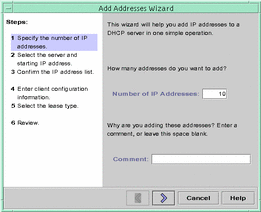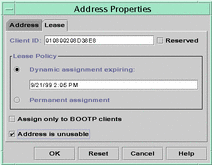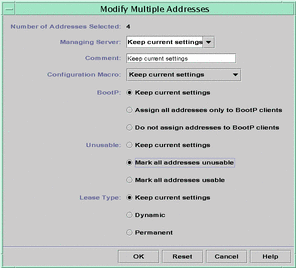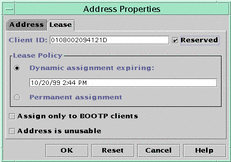Working With IP Addresses in the DHCP Service
You can use DHCP Manager or the pntadm command to add IP addresses, modify their properties, and remove them from the DHCP service. Before working with IP addresses, you should refer to Table 11-6 to become familiar with IP address properties. The table provides information for users of DHCP Manager and pntadm.
Note -
This section does not include procedures for using the pntadm command. However Table 11-6 includes examples of using pntadm to specify IP address properties while adding and modifying IP addresses. Please also refer to the pntadm(1M) man page for more information about pntadm.
The following task map lists tasks you must perform to add, modify, remove IP addresses and the procedures used to carry them out.
Table 11-5 IP Addresses in DHCP Task Map|
Tasks |
Description |
For Instructions, Go To... |
|---|---|---|
|
Add single or multiple IP addresses to DHCP service. |
Add IP addresses on networks that are already managed by the DHCP service using DHCP Manager. |
"How to Create a Single IP Address (DHCP Manager)" |
|
Change properties of an IP address. |
Change any of the IP address properties described in Table 11-6. | |
|
Remove IP addresses from DHCP service. |
Prevent the use of specified IP addresses by DHCP. |
"How to Mark Addresses Unusable (DHCP Manager)" "How to Delete IP Addresses from DHCP Service (DHCP Manager)" |
|
Assign consistent address to a DHCP client. |
Set up a client to receive the same IP address each time it requests its configuration. |
"How to Assign a Consistent IP Address to a DHCP Client (DHCP Manager)" |
The following table lists and describes the properties of IP addresses.
Table 11-6 IP Address Properties|
Property |
Description |
How to Specify in pntadm Command |
|---|---|---|
|
Network address |
Address of the network that contains the IP address you are working with. The network address is displayed in the Networks list on the Addresses tab in DHCP Manager.
|
The network address must be the last argument on the pntadm command line used to create, modify, or delete an IP address. For example, to add an IP address to network 172.21.0.0 pntadm -A ip-address options 172.21.0.0 |
|
IP address |
Address you are working with, whether you are creating, modifying, or deleting it. The IP address is displayed in the first column of the DHCP Manager's Addresses tab. |
The IP address must accompany the -A, -M, and -D options to the pntadm command. For example, to modify IP address 172.21.5.12 pntadm -M 172.21.5.12 options 172.21.0.0 |
|
Client name |
Host name mapped to the IP address in the hosts table. This name may be automatically generated by DHCP Manager or dhcpconfig when addresses are created. If you create a single address, you can supply the name. |
Specify the client name with the -h option. For example, to specify client name carrot12 for 172.21.5.12: pntadm -M 172.21.5.12 -h carrot12 172.21.0.0 |
|
Owning server |
DHCP server that manages the IP address and is responsible for responding to the DHCP client's request for IP address allocation. |
Specify the owning server name with the -s option. For example to specify server blue2 to own 172.21.5.12: pntadm -M 172.21.5.12 -s blue2 172.21.0.0 |
|
Configuration macro |
Macro the DHCP server uses to obtain network configuration options from the dhcptab database. Several macros are created automatically when you configure a server and add networks. See "About Macros" for more information about macros. The server macro is selected by default when DHCP Manager or dhcpconfig create addresses. |
Specify the macro name with the -m option. For example, to assign the server macro blue2 to address 172.21.5.12 pntadm -M 172.21.5.12 -m blue2 172.21.0.0 |
|
Client ID |
Text string derived from the client's hexadecimal hardware address, preceded by the ARP code for the type of network, such as 01 for Ethernet. See Table 13-4 for a full list of ARP hardware codes. For example, a client having the hexadecimal Ethernet address 8:0:20:94:12:1e would use the Client ID 0108002094121E. The client ID is listed in DHCP Manager and pntadm when a client is currently using an address. If you specify a client ID when modifying the properties of an IP address, you manually bind the address to that client for its exclusive use. Tip: As superuser on the client machine, type the following to obtain the Ethernet address for the interface: ifconfig -a |
Specify the client ID with the -i option. For example, to assign client ID 08002094121E to address 172.21.5.12 pntadm -M 172.21.5.12 -i 0108002094121E 172.21.0.0 |
|
Reserved |
Setting that specifies the address is reserved exclusively for the client indicated by the client ID, and the DHCP server cannot reclaim the address. If you choose this option, you manually assign the address to the client. |
Specify that the address is reserved, or manual, with the -f option. For example, to specify that IP address 172.21.5.12 is reserved for a client: pntadm -M 172.21.5.12 -f MANUAL 172.21.0.0 |
|
Lease type |
Setting that determines how DHCP manages the use of the IP address by clients. A lease may be dynamic or permanent. See "Dynamic and Permanent Lease Type" for a complete explanation. |
Specify that the address would be permanently assigned with the -f option. Addresses are dynamically leased by default. For example, to specify that IP address 172.21.5.12 has a permanent lease pntadm -M 172.21.5.12 -f PERMANENT 172.21.0.0 |
|
Lease expiration time |
Date and time when the lease expires, applicable only when a dynamic lease is specified. The date is specified in mm/dd/yyyy format, and is calculated by the DHCP server. |
Specify an absolute lease expiration time with -e. For example, to specify an expiration time of Jaunary 1, 2000: pntadm -M 172.21.5.12 -e 01/01/2000 172.21.0.0 |
|
BOOTP setting |
Setting that marks the address as reserved for BOOTP clients. See "Supporting BOOTP Clients with DHCP Service" for more information about supporting BOOTP clients. |
Reserve an address for BOOTP clients with -f. For example, to reserve IP address 172.21.5.12 for BOOTP clients: pntadm -M 172.21.5.12 -f BOOTP 172.21.0.0 |
|
Unusable setting |
Setting that marks the address so it cannot be assigned to any client. |
Mark an address unusable with -f. For example, to mark IP address 172.21.5.12 unusable: pntadm -M 172.21.5.12 -f UNUSABLE 172.21.0.0 |
Adding Addresses to the DHCP Service
Before you add addresses, you must add the network that owns them to the DHCP service. See "Adding DHCP Networks" for information about adding networks.
You can add addresses using DHCP Manager or dhcpconfig. If you want to use commands to add addresses, use dhcpconfig as explained in "Configuring Networks Using dhcpconfig".
You can add addresses on networks that are already managed by the DHCP service in several ways using DHCP Manager:
-
Create a single IP address - Place one new IP address under DHCP management.
-
Duplicate an existing IP address - Copy the properties of an existing IP address managed by DHCP, and supply a new IP address and client name.
-
Create a range of multiple IP addresses - Use the Address Wizard to place a series of IP addresses under DHCP management.
The following figure shows the Create Address dialog box. The Duplicate Address dialog box is identical to the Create Address dialog box, except that the text fields display the values for an existing address.
Figure 11-8 Create Address Dialog Box

The following figure shows the first dialog of the Address Wizard, used to create a range of IP addresses.
Figure 11-9 Address Wizard

How to Create a Single IP Address (DHCP Manager)
-
Select the Addresses tab.
-
Select the network where the new IP address is to be added.
-
Choose Create from the Edit menu.
The Create Address dialog box opens.
-
Select or type values for the address settings on the Address and Lease tabs.
See Table 11-6 for information about the settings.
-
Click OK.
How to Duplicate an Existing IP Address (DHCP Manager)
-
Select the Addresses tab.
-
Select the network where the new IP address is located.
-
Select the address whose properties you want to duplicate.
-
Choose Duplicate from the Edit menu.
-
Change the IP address and client name for the address.
Most other options should remain the same, but you can change them if necessary.
-
Click OK.
How to Create Multiple Addresses (DHCP Manager)
-
Select the Addresses tab.
-
Select the network where the new IP addresses are to be added.
-
Choose Address Wizard from the Edit menu.
The Address Wizard starts, prompting you to provide values for the IP address properties. See Table 11-6 for more information about the properties. "Making Decisions for IP Address Management" includes more extensive information.
-
Click the right arrow button as you finish entering information in each screen, and click Finish on the last screen.
The Addresses tab is updated with the new addresses.
Modifying IP Addresses in the DHCP Service
After adding IP addresses to the DHCP service, you can modify any of the properties described in Table 11-6 using DHCP Manager or the pntadm -M command. See the pntadm(1M) man page for more information about using pntadm -M.
The following figure shows the Address Properties dialog box that you use to modify IP address properties.
Figure 11-10 Address Properties Dialog Box

The following figure shows the Modify Multiple Addresses dialog box that you use to modify multiple IP addresses.
Figure 11-11 Modify Multiple Addresses Dialog Box

How to Modify IP Address Properties (DHCP Manager)
-
Select the Addresses tab.
-
Select the IP address's network.
-
Select one or more IP addresses you want to modify.
If you want to modify more than one address, press the Control key while clicking with the mouse to select multiple addresses. You can also press the Shift key while clicking to select a block of addresses.
-
Choose Properties from the Edit menu.
The Modify Addresses dialog box or the Modify Multiple Address dialog box opens.
-
Change the appropriate properties.
Refer to Table 11-6 for information about the properties.
-
Click OK.
Removing Addresses From DHCP Service
At times you might want the DHCP service to stop managing a particular address or group of addresses. The method you use to remove an address from DHCP depends on whether you want the change to be temporary or permanent.
-
To temporarily prevent the use of addresses, you can mark them unusable in the Address Properties dialog box as described in "Marking IP Addresses Unusable by the DHCP Service".
-
To permanently prevent the use of addresses by DHCP clients, delete the addresses from the DHCP network tables, as described in "Deleting IP Addresses from DHCP Service".
Marking IP Addresses Unusable by the DHCP Service
You can use the pntadm -M command with the -f UNUSABLE option to mark addresses unusable using the command line.
In DHCP Manager, you use the Address Properties dialog box, shown in Figure 11-10, to mark individual addresses, and the Modify Multiple Addresses dialog box, show in Figure 11-11, to mark multiple addresses, as described in the following procedure.
Deleting IP Addresses from DHCP Service
You should delete IP addresses from the DHCP service database if you no longer want the address to be managed by DHCP. You can use the pntadm -D command or DHCP Manager's Delete Address dialog box.
The following figure shows the Delete Address dialog box.
Figure 11-12 Delete Address Dialog Box

How to Mark Addresses Unusable (DHCP Manager)
-
Select the Addresses tab.
-
Select the IP address's network.
-
Select one or more IP addresses you want to mark unusable.
If you want to mark more than one address unusable, press the Control key while clicking with the mouse to select multiple addresses. You can also press the Shift key while clicking to select a block of addresses.
-
Choose Properties from the Edit menu.
The Modify Addresses dialog box or the Modify Multiple Address dialog box opens.
-
If you are modifying one address, select the Lease tab.
-
Select Address is Unusable.
If you are editing multiple addresses, select Mark All Addresses Unusable.
-
Click OK.
How to Delete IP Addresses from DHCP Service (DHCP Manager)
-
Select the Addresses tab.
-
Select the IP address's network.
-
Select one or more IP addresses you want to delete.
If you want to delete more than one address, press the Control key while clicking with the mouse to select multiple addresses. You can also press the Shift key while clicking to select a block of addresses.
-
Choose Delete from the Edit menu.
The Delete Address dialog box opens listing the address you selected so you can confirm the deletion.
-
If you want to delete the host names from the hosts table, select Delete From Hosts Table.
If the host names were generated by DHCP Manager or dhcpconfig, you might want to delete the names from the hosts table.
-
Click OK.
Setting Up DHCP Clients for a Consistent IP Address
The Solaris DHCP service attempts to provide the same IP address to a client that has previously obtained an address through DHCP. However, it is not always possible when dynamic leasing is in use.
Routers, NIS/NIS+, DNS servers, and other hosts critical to the functioning of a network should not use DHCP because they should not rely on the network to obtain their IP addresses. Clients such as print or file servers should have consistent IP addresses as well, but can be set up to receive their network configurations through DHCP.
You can set up a client to receive the same IP address each time it requests its configuration by reserving, or manually assigning, the client's ID to the address you want it to use. You can set up the reserved address to use a dynamic lease to make it easy to track the use of the address, or a permanent lease if you do not require use tracking. However, permanent leases are not recommended because once a client obtains a permanent lease, it does not contact the server again and cannot obtain updated configuration information unless it releases the IP address and restarts the DHCP lease negotiation.
You can use pntadm -M command or DHCP Manager's Address Properties dialog box.
The following figure shows the Lease tab of the Address Properties dialog box used to modify the lease.
Figure 11-13 Address Properties Lease Tab

How to Assign a Consistent IP Address to a DHCP Client (DHCP Manager)
-
Determine the client ID for the client you want to have a permanent IP address.
See the entry for client ID in Table 11-6 for information about determining the client ID.
-
Select the Addresses tab in DHCP Manager.
-
Select the appropriate network.
-
Double-click the IP address you want to the client to use.
The Address Properties window opens.
-
Select the Lease tab.
-
In the Client ID field, type the client ID you determined from the client's hardware address.
-
Select the Reserved option to prevent the IP address from being reclaimed by the server.
-
In the Lease Policy area of the window, select Dynamic or Permanent assignment.
Select Dynamic if you want the client to negotiate to renew leases, and thus be able to track when the address is being used. (Because you selected Reserved, the address cannot be reclaimed even when using dynamic leasing.) You do not need to enter an expiration date for this lease; the DHCP server calculates the expiration date based on the lease time.
Selecting Permanent is not recommended because you cannot track the use of the IP address unless you enable transaction logging.
- © 2010, Oracle Corporation and/or its affiliates
